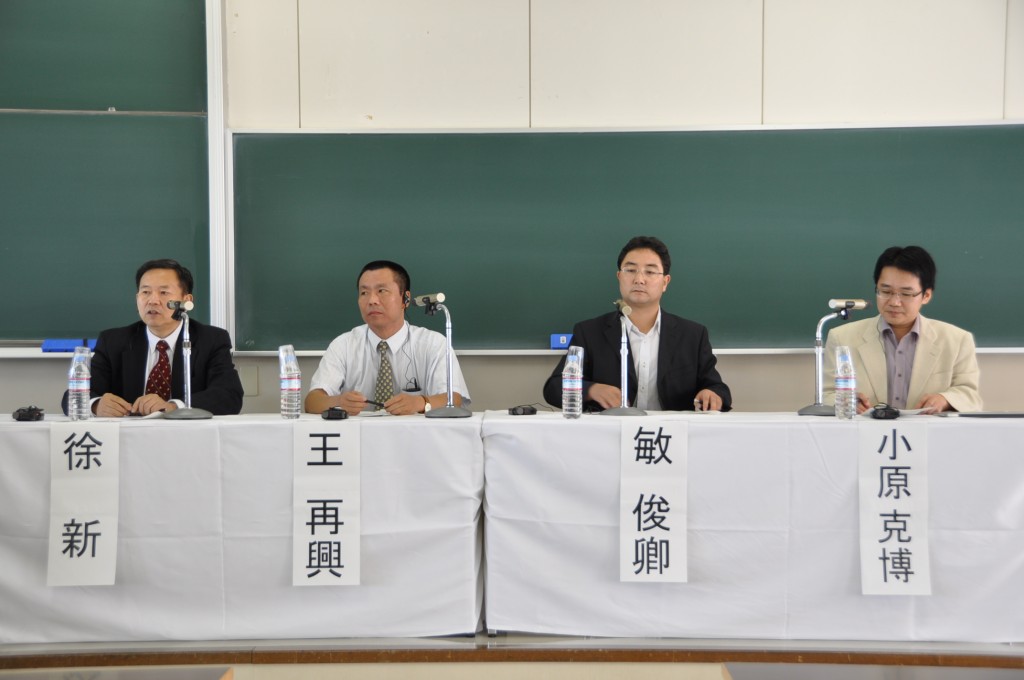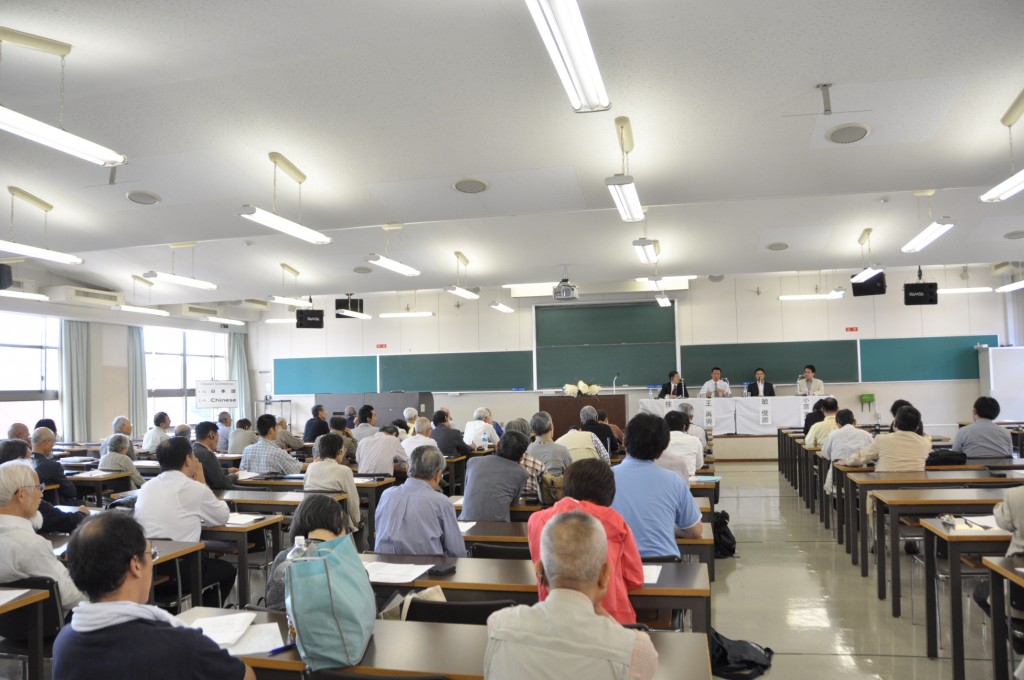Center for Interdisciplinary Study of Monotheistic Religions(CISMOR)Doshisha University
> Public Lectures > Religion in China: Focusing on the Monotheistic ReligionsPublic Lectures
Public Lecture from Symposium by Project 1
Religion in China: Focusing on the Monotheistic Religions
| Date: |
2011/09/24 13:00 − 15:15 |
|---|---|
| Place: | Room Z40, Jinshin-kan 4F, Shinmachi Campus, Doshisha University |
| Lecture: |
Xu Xin, Professor of Nanjing University/ Director of Center for Jewish Studies John Z. X. Wang, Lecturer of Xiangfan University/ CISMOR Visiting Researcher Min Junqing, Vice Secretary-General of China Hui Studies Association |
| Summary: | |
|
As the most populous country in the world and as a country that is currently in the process of rapid economic growth, China is the world’s largest “non-Christian country” but its Christian population is estimated at 100 million (10% of the entire population). China is also home to tens of millions of Muslims, who mostly consist of the Hui people and who are geographically widespread, as well as to Jewish communities that boast a very long history though having only a limited population. In this public lecture, presentations were made by Chinese researchers who specialize in Judaism, Christianity, and Islam as they exist in China for the shared purpose of deepening the understanding of the monotheistic religions in this country today, which is characterized by the unique religious background and diversity. Xu Xin: Tracing Judaism in China According to Prof. Xin, the history of Judaism in China can be divided into three main phases. The first phase is the period up to 1840 when China opened its doors to Western powers. In this period, a Jewish community in Kaifeng is especially famous for its 1,000-year-old history. The second phase began with the arrival of “modern Jews” to China following the opening of its doors, and these Jews built their own communities in foreign concessions in major port cities, firstly in Hong Kong, and then in Shanghai, Harbin, and Tianjin. Unlike Jews in Kaifeng, these newcomers were distinguished sharply as “foreigners.” The third phase is the period after World War II, specifically after 1949 when the Communists took power in China. Before then, about 40,000 “newcomer” Jews lived in China, including those fleeing from the Nazi regime, but during this period, most of them left China as they could not continue trading and other business activities, excluding those who opted to stay in Hong Kong, which remained under British control. The Jewish presence in China has been revived since 1978, when the Chinese government launched a reform and opening-up policy, partly to attract foreign investment (this resembles the situation following China’s opening-up in 1840). To be specific, the government now allows rabbis to propagate Judaism, and at one time, even offered support to renovate a historical synagogue into a museum. Today, several synagogues are open in Beijing, where no Jewish community had existed previously. John Z. X. Wang: Christianity in China Today Then, Dr. Wang discussed the current situation of Christianity in China through a comparison between “official churches” and “house churches” (underground churches). Official churches refer to the Protestant and Catholic churches that belong to, respectively, the “Three-Self Patriotic Movement Committee” and the “Chinese Patriotic Catholic Association,” both of which are nationwide agencies responsible for managing churches and which are placed under the control of the government. According to the statistics of the government, China has a Christian population of about 30 million (of whom 6 million are Catholic Christians) who belong to these official churches. (As is publicly known, China does not have formal diplomatic relations with the Vatican, and therefore, does not admit the mandate of Pope.) On the other hand, churches that are not recognized by the government are collectively (casually) called “house churches,” and no unified organization exists to represent them—even on a local level. Apparently, official churches, which are protected by the government and which have inherited fine chapels left by Western missionaries, seem to be better managed than house churches. However, Dr. Wang argued that official churches have remained unable to cope well with the rapid changes of society resulting from the introduction of the reform and opening-up policy and are impeded by the government’s intervention, though he recognized the historical importance of the “Three-Self” Patriotic Movement (Three-Self: Self-governance, self-support, and self-propagation) that aims to move away from dependence on foreign support. Rather, it is house churches that are going their “own way” in a true sense (or, that are following the “free market pattern,” as Dr. Wang calls it) with the support of grassroots mass movements, and it is often the case that young leaders of such movements double as leaders of pro-democracy movements. For this reason, the Chinese government is providing enhanced control and supervision over the activities of house churches, but, as Dr. Wang insisted, the mainstream of Christianity in China is shifting to house churches with support by people from a broader range of social classes. Min Junqing: Islam in China Mr. Min explained the “development” of Islam in China focusing on the situation during the last decade. According to the data of the Chinese government, the Muslim population of China amounts to about 23 million, and the Hui people in Gansu Province and Qinghai Province (consisting of several tribes) and Muslims in Xinjiang (consisting of six ethnic groups) constitute the majority of the Chinese Muslim population. (Note that this number does not include non-Muslim Hui people and non-traditional Muslims.) The Hui people and other Muslims are geographically widespread throughout China, covering the largest area of the country, next to the Han people. For this reason, Chinese Muslims are widely diversified and have distinctive cultural and regional characteristics. Their religious activities are guided by the Islamic Association of China, a nationwide organization established under the auspices of the Chinese government. In this light, Mr. Min emphasized that the religious needs of Chinese Muslims are basically satisfied. For example, the Islamic Association of China organizes annual pilgrimage tours, sending large groups of pilgrims to Mecca, while Islamic clerics are trained at the Association’s Islamic seminaries or private schools. There is one mosque per every 400 Muslims on average in China. The mobility of Chinese Muslims, both at home and abroad, is very high, which causes substantial influence on Chinese society at large. (The main causes of such mobility are: 1) Migration of the Hui people to coastal areas, 2) Pilgrimages to Mecca, and 3) Exchanges with Southeast Asia.) Against the backdrop of such “development,” Islamic research in China has expanded in terms of both quality and quantity since the 1990s, with young researchers from the Hui people having increased their presence since 2000. Following these three presentations, a panel discussion and then a closed workshop were held, in which a heated discussion took place on a very wide range of issues concerning the themes of the presentations. The main topics of discussion were: In terms of Judaism, whether there was discrimination against Jews or not, and what made Jews leave China after the Communists took power in China; in terms of Christianity, how it was associated with pro-democracy movements; and in terms of Islam, the process of the establishment of a nationwide unified organization and the education and training of Imams (Muslim leaders). According to Prof. Xin, religious difference has not been the cause of any serious problem throughout the history of China, and the Western stereotypes of “Jews” have been unknown to the Chinese. Therefore, the reasons for Jews choosing to leave China consist of economic difficulties and the hard-line religious control measures taken by the Communist government in the early days of its establishment. Dr. Wang explained that the Chinese government, after introducing the reform and opening-up policy, welcomed Christianity in principle, aware of the importance of fostering cooperative ties with Western countries. Recently, however, as house churches are showing signs of joining pro-democracy activities, the government has grown more cautious of the movement of Christians, occasionally taking more suppressive measures against them. This has been especially the case since the emergence of the pro-democracy movements in the Middle East (Arab Spring). Mr. Min pointed out the semi-public nature of the Islamic Association of China—which was established under the auspices of the Chinese government and which is supported entirely by the government regarding financial and personnel management. He also noted the existence of Islamic organizations equivalent in nature to Christian underground churches (house churches). However, the absolute number of Imams is still not quite enough, and the standard of education of Islamic clerics is by no means higher than that of Christian clerics. To improve such a situation, the Islamic Association of China, with the support of the Chinese government, is now working to enhance and expand its member seminaries. Upon the completion of such work, the seminaries can accept a substantially larger number of students, offer a wider range of educational programs with degrees up to the doctoral level, and invite teachers from abroad. While overseas study can be an effective way for training high-caliber Imams, the Chinese government places importance on domestic training. For this reason, the expansion of domestic seminaries bears special importance for the government. Tadashi Nakatani (Research Fellow, CISMOR, Doshisha University) |
|
|
【Program】 ◆Lecture "Tracing Judaism in China" Xu Xin "Christianity in China Today" John Z. X. Wang "Islam in China" Min Junqing ◆Panel Discussion *This lecture will be given in Chinese. *Admission Free, No Reservation Necessary. Hosted by: CISMOR Co-hosted by: School of Theology, Doshisha University |
|
|
Program (Japanese) |
|

